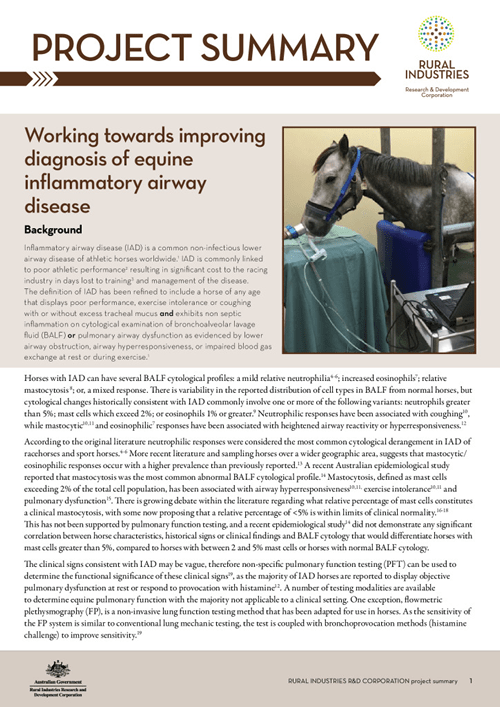Fact sheet: Equine herpes virus
Equine herpes virus (EHV) is a DNA virus found in horses all around the world. There are different strains of EHV, with the most common...
 THOROUGHBRED HORSES
THOROUGHBRED HORSES 
Published: 9 Apr 2015
Author(s): Secombe, Cristy
Download report PDF
DownloadInflammatory airway disease (IAD) is a common non-infectious lower airway disease of athletic horses worldwide (Couetil LL, Hoffman AM, Hodgson J, et al.). IAD is commonly linked to poor athletic performance (Richard EA, Fortier GD, Pitel PH, et al.) resulting in significant cost to the racing industry in days lost to training(Wilsher S, Allen WR, Wood JLN)and management of the disease. The definition of IAD has been refined to include a horse of any age that displays poor performance, exercise intolerance or coughing with or without excess tracheal mucus and exhibits non septic inflammation on cytological examination of bronchoalveolar lavage fluid (BALF) or pulmonary airway dysfunction as evidenced by lower airway obstruction, airway hyperresponsiveness, or impaired blood gas exchange at rest or during exercise (Couetil LL, Hoffman AM, Hodgson J).
The primary objective of this project was to examine the relationship between BALF cytology and PFT findings in a group of sedentary horses maintained in a consistent environment. The first aim was to determine if cytological changes within BALF, particularly the relative mast cell percentage, was correlated with AHR, as determined by PFT. A secondary aim was to determine if mast cell tryptase (MCT), a marker of mast cell degranulation correlated with cytological changes within BALF or PFT in this geographical location.
The second objective was to examine the relationship between BALF cytology and PFT in horses presented for evaluation of poor performance that required a respiratory tract evaluation. This was investigated using similar aims and methods to that described for the primary study objective with the exception that two geographic regions were included.